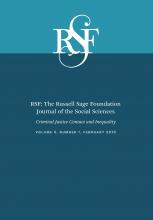Research Article
Open Access
Level of Criminal Justice Contact and Early Adult Wage Inequality
Robert Apel, Kathleen Powell
RSF: The Russell Sage Foundation Journal of the Social Sciences February 2019, 5 (1) 198-222; DOI: https://doi.org/10.7758/RSF.2019.5.1.09
Robert Apel
Professor at the School of Criminal Justice at Rutgers University–Newark, 123 Washington St., Newark, NJ 07102

References
- ↵
- Agan, Amanda, and
- Sonja Starr
- Apel, Robert, and
- Anke Ramakers
- ↵
- Andersen, Signe Hald
- ↵
- Bernburg, Jön Gunnar, and
- Marvin D. Krohn
- ↵
- Borgen, Nicolai T
- ↵
- Bound, John, and
- Richard B. Freeman
- ↵
- ↵
- Brame, Robert,
- Michael G. Turner, ,
- Raymond Paternoster, and
- Shawn D. Bushway
- ↵
- Bureau of Labor Statistics, Department of Labor
- ↵
- Center for Human Resource Research
- ↵
- Cohen, Jacob
- ↵
- Decker, Scott H.,
- Natalie Ortiz,
- Cassia Spohn, and
- Eric Hedberg
- Dennison, Christopher R., and
- Stephen Demuth
- ↵
- ↵
- Fagan, Jeffrey, and
- Richard B. Freeman
- ↵
- Firpo, Sergio
- ↵
- Firpo, Sergio,
- Nicole M. Fortin, , and
- Thomas Lemieux
- Galgano, Sarah W
- ↵
- Garland, David
- ↵
- Garland, David
- ↵
- Geller, Amanda,
- Irwin Garfinkel, and
- Bruce Western
- ↵
- Gelman, Andrew,
- Jeffrey Fagan, and
- Alex Kiss
- ↵
- Grogger, Jeffrey
- ↵
- Harlow, Caroline Wolf
- ↵
- Hirschfield, Paul
- ↵
- Hjalmarsson, Randi
- ↵
- Holzer, Harry J
- ↵
- Holzer, Harry J.,
- Steven Raphael, and
- Michael A. Stoll
- ↵
- Jung, Haeil
- ↵
- Jung, Haeil
- ↵
- Killewald, Alexandra, and
- Jonathan Bearak
- Kirk, David S
- ↵
- Kirk, David S., and
- Robert J. Sampson
- ↵
- Kirk, David S., and
- Sara Wakefield
- Kling, Jeffrey R
- ↵
- Koenker, Roger
- ↵
- Koenker, Roger, and
- Gilbert Bassett Jr.
- ↵
- ↵
- ↵
- Matsueda, Ross L.,
- Rosemary Gartner,
- Irving Piliavin, and
- Michael Polakowski
- Nagin, Daniel, and
- Joel Waldfogel
- Nagin, Daniel, and
- Joel Waldfogel
- ↵
- Needels, Karen E
- ↵
- ↵
- Pager, Devah
- ↵
- Pager, Devah
- ↵
- Pager, Devah,
- Bruce Western, and
- Bart Bonikowski
- ↵
- Pager, Devah,
- Bruce Western, and
- Naomi Sugie
- ↵
- Patterson, Evelyn J., and
- Christopher Wildeman
- ↵
- Pettit, Becky
- ↵
- Pettit, Becky, and
- Bruce Western
- ↵
- Phelps, Michelle S
- ↵
- ↵
- Raphael, Steven
- ↵
- Sampson, Robert J
- ↵
- Sampson, Robert J
- ↵
- Sampson, Robert J., and
- John H. Laub
- ↵
- Sampson, Robert J., and
- Janet L. Lauritsen
- ↵
- Shannon, Sarah K. S.,
- Christopher Uggen,
- Jason Schnittker,
- Melissa Thompson,
- Sara Wakefield, and
- Michael Massoglia
- ↵
- Smith, Douglas A
- ↵
- Steffensmeier, Darrell,
- Jeffrey Ulmer, and
- John Kramer
- ↵
- Stoll, Michael A
- ↵
- ↵
- Sweeten, Gary
- ↵
- Travis, Jeremy,
- Bruce Western, and
- Steve Redburn
- ↵
- Turney, Kristin
- ↵
- Uggen, Christopher,
- Mike Vuolo,
- Sarah Lageson,
- Ebony Ruhland, and
- Hilary K. Whitham
- ↵
- Vuolo, Mike,
- Sarah Lageson, and
- Christopher Uggen
- ↵
- Wacquant, Loïc
- ↵
- Wakefield, Sara, and
- Christopher Uggen
- ↵
- Wakefield, Sara, and
- Christopher Wildeman
- ↵
- ↵
- Waldfogel, Joel
- ↵
- Western, Bruce
- Western, Bruce
- ↵
- ↵
- ↵
- Western, Bruce,
- Jeffrey R. Kling, , and
- David F. Weiman
- ↵
- Widdowson, Alex O.,
- Sonja E. Siennick, , and
- Carter Hay
In this issue
Level of Criminal Justice Contact and Early Adult Wage Inequality
Robert Apel, Kathleen Powell
RSF: The Russell Sage Foundation Journal of the Social Sciences Feb 2019, 5 (1) 198-222; DOI: 10.7758/RSF.2019.5.1.09
Jump to section
Related Articles
- No related articles found.
Cited By...
- No citing articles found.





